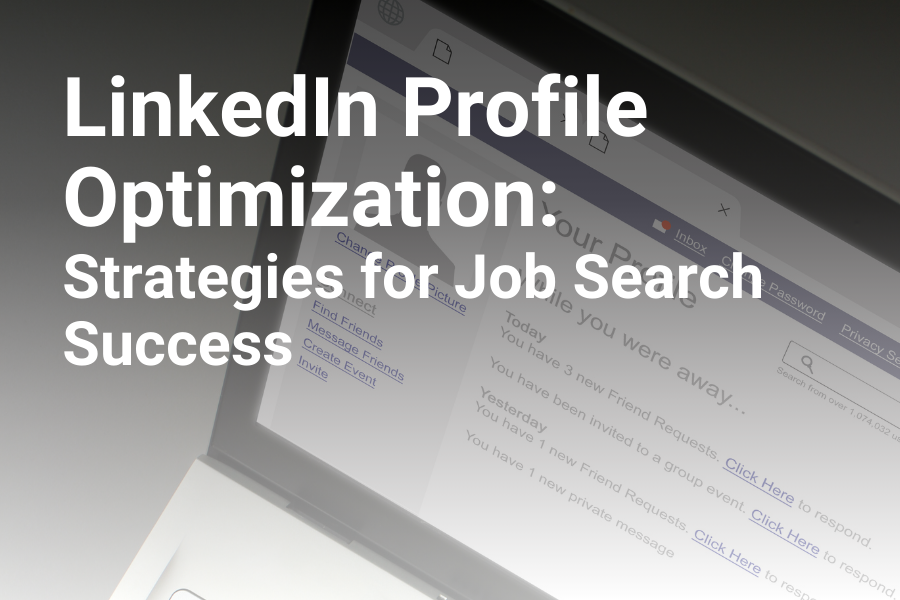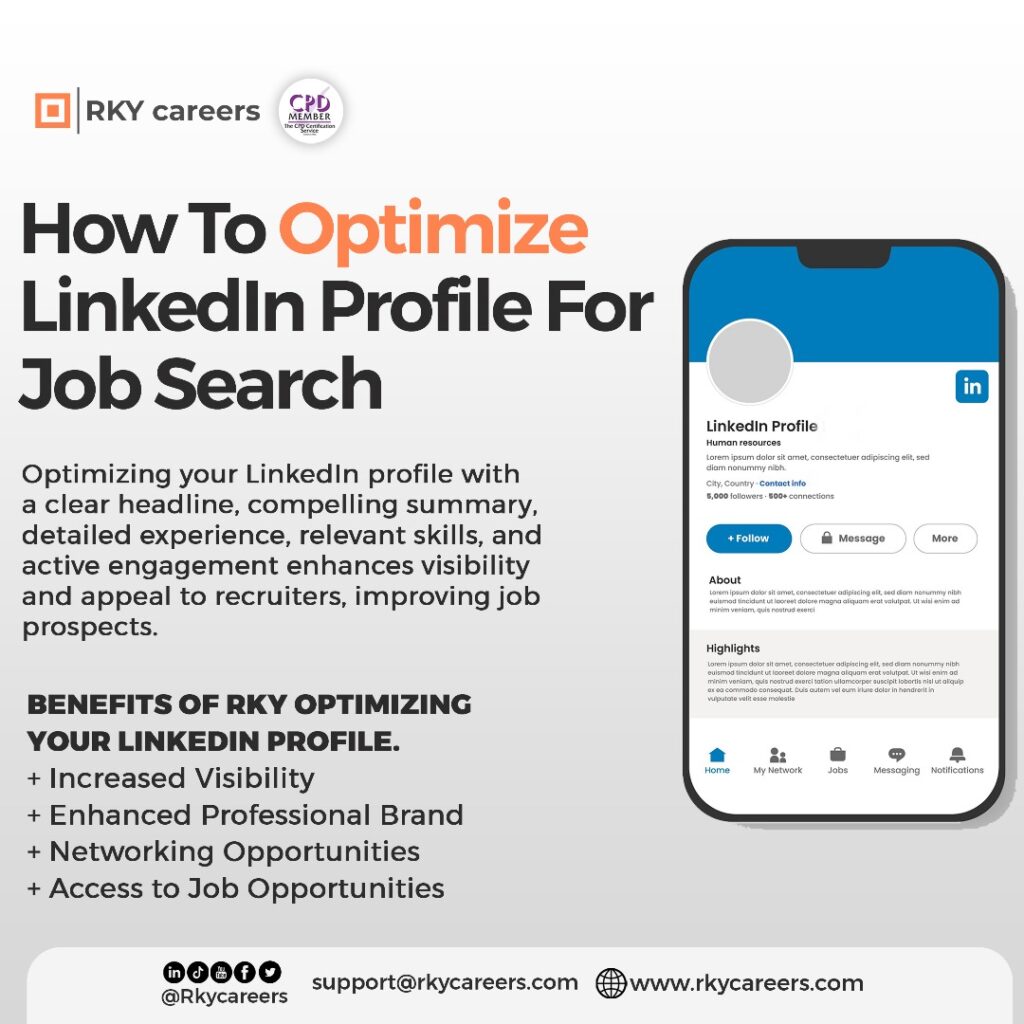Finding a job in today's competitive market can feel overwhelming, but LinkedIn is here to help. As a powerful professional networking platform, LinkedIn connects job seekers with employers, offers valuable resources, and showcases your skills and experiences to the right audience. If you're navigating the job search journey, leveraging
Creating an Impressive LinkedIn Profile

Your LinkedIn profile is essentially your digital resume, but it's so much more than that. It's your chance to present yourself as the ideal candidate to potential employers. Here’s how to create a standout profile that grabs attention:
- Profile Photo: First things first, choose a professional-looking headshot. Your photo should present you in a positive light, so smile and wear professional attire. Remember, photos of you at events or cropped group shots don’t make the cut.
- Compelling Headline: Your headline is one of the first things people see. Instead of just stating your job title, consider including key skills or what you’re seeking. For example, "Marketing Specialist | Data-Driven Strategist | Open to New Opportunities."
- Optimized Summary: Your summary is your elevator pitch. Write a brief overview of your background, skills, and what makes you unique. Aim for a conversational tone and don't hesitate to showcase your personality. It can help you stand out among countless profiles!
In addition to these essentials, here are a few more tips to enhance your profile:
- Work Experience: Detail your work history, but focus on achievements rather than just duties. Use bullet points to make your accomplishments easy to read. Contextualize how you contributed to past teams or projects. For instance, rather than saying "Managed a team," try "Led a cross-functional team of 10 to increase project efficiency by 20%."
- Skills & Endorsements: List relevant skills that showcase your qualifications. Aim for a mix of hard and soft skills. Don’t be shy about asking colleagues or connections to endorse you for these skills; it adds credibility to your profile!
- Recommendations: Request written recommendations from former managers, colleagues, or clients. A well-crafted recommendation can make a lasting impression on potential employers. It’s a great way to demonstrate real-world validation of your accomplishments.
Lastly, keep your profile updated! Regularly add new accomplishments, skills, or certifications to reflect your latest experiences. Consistent updates signal to potential employers that you're active and engaged in your career. If used effectively, your LinkedIn profile can be a powerful tool in your job search arsenal.
By focusing on these key elements, you can create an impressive LinkedIn profile that not only attracts recruiters but also helps you connect with a broader professional network. Happy networking!
Also Read This: What Is the Cost of LinkedIn Recruiter Lite? Features and Pricing
3. Building a Strong Network on LinkedIn

When it comes to job searching, your network is a powerful tool. Think of LinkedIn as a digital meeting place where professionals from all walks of life congregate. The more connections you have, the more opportunities can come your way. Let’s dive into some strategies to help you build a strong network on LinkedIn.
Start by optimizing your profile. Before you begin sending out connection requests, make sure your profile is complete. A professional profile picture, a compelling headline, and a well-written summary can make a world of difference. When others see your profile, especially potential contacts, they should instantly grasp who you are and what you bring to the table.
Personalize your connection requests. Instead of the default message, take a moment to add a personal note. Mention how you know them or why you’d like to connect. This shows that you're sincere and genuinely interested in developing a relationship, not just collecting connections.
Engage with your connections. Don’t just let your network sit idle! Like, comment, and share posts from your connections. This not only keeps you top-of-mind but demonstrates your expertise and interests. Plus, it can lead to opportunities, as people may think of you when they hear about job openings or projects relevant to your skills.
Join LinkedIn groups. Finding groups where professionals in your field gather can give you invaluable connections and insights. Participate in discussions, ask questions, and share your knowledge. This can expand your visibility and help you connect with like-minded individuals or industry leaders.
Don’t forget the power of follow-ups. If you meet someone at a networking event or through mutual connections, send them a LinkedIn request! Always reference where you met or a common interest. Maintaining contact with existing connections through occasional messages or updates can also deepen those relationships over time.
Remember, networking is about quality over quantity. Rather than aiming for thousands of connections, focus on nurturing a smaller number of meaningful relationships. By building a strong network, you set the stage for thriving job searches!
Also Read This: How to Block People in LinkedIn: A Step-by-Step Guide to Managing Your LinkedIn Network
4. Utilizing LinkedIn Job Search Features

Alright, now that you’ve built a solid network, let’s explore how to effectively leverage LinkedIn’s job search features. LinkedIn is more than just a social media platform; it’s a treasure trove of job opportunities. Here are some ways to navigate its features:
Utilize the Job Search Tool. LinkedIn’s job search feature allows you to filter jobs by various criteria like location, industry, and experience level. Use these filters to hone in on your ideal roles. Don’t forget to set up job alerts for positions that fit your criteria—this way, you’ll be one of the first to know when new opportunities arise!
Research companies thoroughly. LinkedIn provides a glimpse into company culture, job postings, and employee reviews. Before applying, take time to research the companies you’re interested in. Look at their recent posts, what employees say, and how they align with your values. This knowledge can help you tailor your application and interview responses.
Show your interest through “Easy Apply.” Some job postings have an “Easy Apply” feature, allowing you to submit your profile directly. While this makes applying quick and easy, take time to adjust your application or attach a tailored resume whenever possible. Personalization can significantly boost your chances of catching a recruiter’s eye.
Connect with recruiters or hiring managers. After you find a job that piques your interest, consider reaching out directly to the recruiter or the hiring manager through LinkedIn. A polite message expressing your interest and summarizing your qualifications can set you apart from other candidates. Just ensure you’re professional and don’t come off as overly pushy!
Leverage LinkedIn Learning. Want to strengthen your profile? Use LinkedIn Learning to gain new skills, enhance your knowledge, and acquire certifications. Completing relevant courses can make your application more attractive and show potential employers you’re proactive and dedicated to self-improvement.
In short, LinkedIn is a robust platform equipped with tools that can simplify your job search. By utilizing these job search features effectively, you can enhance your visibility, tailor your applications, and ultimately land the job that's right for you!
Also Read This: What Does the Green Dot on LinkedIn Mean? Real-Time Status Explained
5. Engaging with LinkedIn Groups and Communities
If you're looking to maximize your job search opportunities on LinkedIn, one of the best strategies is to engage with LinkedIn Groups and communities. These spaces serve as a hub for professionals who share similar interests, industries, and career goals. Here’s how you can make the most of these groups:
- Join Relevant Groups: Start by searching for groups that align with your industry or job interests. Whether you're in tech, marketing, healthcare, or any other field, there are numerous groups out there. You can find these by using LinkedIn's search bar and filtering for groups.
- Participate Actively: Don’t just be a wallflower! Engage in discussions, answer questions, and share relevant articles. By contributing valuable insights, you’ll position yourself as an expert in your field.
- Network with Members: Groups are not only about discussions; they are also great for networking. Reach out to other group members through direct messages. Introduce yourself politely and express your interest in connecting over shared topics.
- Share Opportunities: If you come across job postings or relevant resources, make sure to share them in the group. People will appreciate your initiative and this can lead to more meaningful connections.
- Stay Updated: Many groups often discuss industry trends or upcoming events. By engaging here, you can stay informed and even discover potential opportunities that you wouldn’t have found otherwise.
Remember, the key to successful engagement in LinkedIn groups is to be consistent and authentic. Building relationships takes time, but the connections you make can significantly enhance your job search efforts. So jump in, start contributing, and watch your professional network grow!
Also Read This: How Can You Tell If Someone Has LinkedIn Premium? Features and Indicators
6. Optimizing Your LinkedIn Activity for Visibility
Your activity on LinkedIn plays a significant role in how visible you are to recruiters and potential employers. By optimizing your LinkedIn activity, you can effectively boost your presence and connect with those who are hiring. Here are some strategies to consider:
- Post Regularly: Keep your profile active by posting regularly. This could be industry news, personal achievements, or even thoughts on relevant articles. Regular posts signal to the LinkedIn algorithm that you're an engaged member of the community.
- Use Hashtags Wisely: When you post, include relevant hashtags. This helps your content reach a wider audience beyond just your immediate connections. Aim for a mix of popular and niche hashtags to maximize visibility.
- Seek Endorsements and Recommendations: Don't hesitate to ask colleagues or former bosses for endorsements on your skills and recommendations. These add credibility to your profile and make you more appealing to prospective employers.
- Engage with Others' Content: Like, comment on, and share others' posts. This not only helps build relationships but also increases your visibility. When you engage with someone’s content, it appears on your network’s feeds, allowing you to reach a wider audience.
- Monitor Your Analytics: LinkedIn provides analytics on your posts, profile views, and engagement levels. Keep an eye on these metrics to understand what type of content resonates most with your audience and adjust your strategy accordingly.
Optimizing your LinkedIn activity means being intentional about how you present yourself online. When you actively engage and share meaningful content, you're not just increasing your visibility—you're also building a personal brand that can attract the right job opportunities. So take charge of your LinkedIn presence and let it work for you!
Also Read This: How to Save LinkedIn Learning Videos on Your PC for Offline Viewing
7. How to Tailor Your Applications on LinkedIn
When it comes to job hunting on LinkedIn, generic applications can hurt your chances of being noticed. You want to be the candidate that stands out—not the one who looks like they just clicked "apply" on every listing they came across. So, how do you tailor your applications effectively? Let’s break it down!
First off, research is key. Check out the company’s LinkedIn page, its website, and even its employee reviews on platforms like Glassdoor. Get a feel for their culture, values, and what they prioritize in their employees. This insight will help you align your application with what they’re truly looking for.
Next, focus on customizing your resume and cover letter for each application. Here are some proven strategies:
- Keyword Match: Use keywords from the job description in your resume and cover letter. If the job asks for "project management skills," make sure you include that exact phrase if it applies to you!
- Highlight Relevant Experience: Not all your work experiences are going to be relevant to every job. Choose specific roles or projects where you demonstrated skills that directly relate to the job you’re applying for.
- Tailor Your LinkedIn Profile: Your LinkedIn profile should mirror the direction of your application. If you highlight a certain skill in your application, make sure it’s also reflected prominently on your LinkedIn profile.
Another useful tip is to reach out to current or former employees at the company. A simple "Hi, I saw that you’re connected to [Company]. Could you share some insight on the company culture or what the team is looking for?" can go a long way. People love sharing their experiences, and this may also give you some unique information that you can incorporate into your application.
Finally, consider creating a LinkedIn “About” section that speaks directly to your desired role. Make it clear what kind of opportunities you are looking for and how your experiences and aspirations align with the potential employer’s needs. This not only helps in tailoring your application but also in making a memorable first impression on recruiters checking out your profile.
Also Read This: How to Become a LinkedIn Influencer and Grow Your Professional Brand
8. Leveraging Recommendations and Endorsements
One of LinkedIn’s standout features is its ability to showcase your credibility through recommendations and endorsements. If you’re not taking advantage of these tools in your job search, you might be missing out on a significant boost to your reputation!
Let’s talk about recommendations first. A recommendation is a personalized testimonial from someone you’ve worked with. These carry a lot of weight, as they provide a third-party validation of your skills and work ethic. Here’s how you can get effective recommendations:
- Ask Strategically: Reach out to colleagues, managers, or clients who can speak to your strengths. Make sure these people are familiar with your work and can provide specific examples of your contributions.
- Be Specific in Your Request: When asking for a recommendation, let them know what you’d like them to focus on. For example, “Could you highlight my leadership abilities during the XYZ project?” This offers more targeted and relevant feedback.
- Offer to Return the Favor: If you’re asking someone to take time to write a recommendation for you, offer to write one for them as well. It’s a nice way to encourage reciprocity.
Now, let’s discuss endorsements. When others endorse your skills, it adds credibility to your profile. Here are a few tips for maximizing endorsements:
- List Relevant Skills: Only include skills that are pertinent to your job search. If you’re looking for a project management role, make sure “Project Management” is endorsed rather than a less relevant skill.
- Be Active in Your Network: Endorse others for their skills genuinely. The more you endorse, the more likely they are to return the favor!
- Engage with Your Network: Join industry-related groups and participate in discussions. This can lead to more connections and consequently more endorsements.
Leveraging these recommendations and endorsements effectively can transform your LinkedIn profile into a powerful tool that attracts recruiters and employers, increasing your chances of standing out in a competitive job market. So don’t hesitate—start reaching out and let your connections advocate for you!
Conclusion: Taking Action on Your LinkedIn Strategy
To truly maximize your job search opportunities on LinkedIn, it's crucial to take definitive and strategic actions. Simply having a profile isn't enough; you need to actively engage with the platform. Here are some steps you can implement today:
- Optimize Your Profile: Ensure your profile is complete with a professional photo, a compelling summary, and relevant work experiences.
- Expand Your Network: Connect with industry professionals, recruiters, and alumni. Aim to personalize your connection requests to foster genuine relationships.
- Engage with Content: Share articles, comment on posts, and write your own posts to increase your visibility and showcase your expertise.
- Utilize Job Alerts: Set up job alerts to stay informed about new opportunities aligned with your skills and interests.
- Join Relevant Groups: Participate in industry-specific groups to network, gain insights, and discover job postings that may not be widely advertised.
Remember, action leads to visibility and opportunity. By actively managing your LinkedIn presence and engaging with your network, you'll significantly enhance your chances of finding the right job. Schedule regular times each week to focus on your LinkedIn strategy, and don't shy away from reaching out to recruiters directly.
In conclusion, taking action on your LinkedIn strategy is essential for unlocking potential job opportunities and establishing a strong professional presence in today's competitive job market.
 admin
admin








